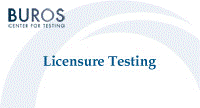Buros-Nebraska Series on Measurement and Testing
Date of this Version
1995
Document Type
Article
Citation
Licensure Testing: Purposes, Procedures, and Practices, ed. James C. Impara (Lincoln, NE: Buros Institute of Mental Measurements, University of Nebraska-Lincoln, 1995).
Abstract
Item banks developed by licensure agencies range from a collection of items stored on index cards to highly sophisticated electronic databases. Regardless of the storage mechanism, most banks contain items that have been organized and referenced according to procedures established by the licensure agency. This chapter outlines useful practices for building and maintaining a computerized item bank. We address storage of item text, graphics, and statistical history. We deal with the creation of paper-and-pencil and computerized tests from an item bank and the use of Item Response Theory (lRT) to calibrate and equate item banks. New directions in item banking are also discussed.
Apparently coined in England during the mid-1960s, the term "item bank" was used to describe a group of test items that were "organized, classified and catalogued like books in a library" (Choppin, 1985). Subsequently, Bruce Choppin and others interested in item banking based on Item Response Theory (Hathaway, Houser, & Kingsbury, 1985) attempted to distinguish between "item banks" (a collection of items calibrated with an IRT measurement system and equated to a common scale) and "item pools" (collections of items grouped by content but not calibrated). This distinction has not been widely embraced and often today the terms "item bank" and "item pool" are used interchangeably.
Computerized item banking employs a computer software program to store collections of test items and their associated classifications and statistics. Computerization allows easy storage and retrieval of hundreds (for some organizations the number may be thousands or even tens of thousands) of items. A well organized, well-maintained computerized item bank can facilitate and enhance the construction of both paper-and-pencil and computerized tests. Items can be sorted and filtered to enable easy review by content experts and psychometric staff.
The basic plan for item bank construction includes writing content valid, grammatically correct items (see Chapters 5 & 6), categorizing items according to the content outline or "blueprint" that the testing agency utilizes, and entering the items into the computerized bank.
Once a valid item bank is created, the orchestrated efforts of content experts and psychometricians are required to maintain it. Content experts must review the item bank on a systematic schedule to ensure that (a) items are current and relevant to the field of practice; (b) duplicate and similar items are identified and flagged; and (c) content within the bank is representative of the test blueprint. Psychometricians must also review the bank to guarantee that (a) the range of item difficulty is appropriate; (b) misfitting items have been identified and flagged for rewrite; and (c) the pass/fail standard is current.
Licensure and certification agencies test a large range of candidates. Some agencies test less than 50 candidates per year whereas others test hundreds of thousands of candidates. Still, even agencies that test relatively few candidates usually have item banks of at least several hundred items. Although switching to computerized item banking involves the initial cost of developing or purchasing software and possible conversion costs for existing items, graphics, and statistics into the computerized bank, cost savings are realized in the long run by reducing professional and clerical time for item maintenance and test production. Another important benefit of computerization is reduction of error- the more data are manually manipulated, the greater the chance for mistakes. Thus, even very small testing agencies will benefit by computerizing their item banks.
The following sections of this chapter outline various computerized item banking components. Licensure agencies need to review their item banking needs (both current and future) to decide which components of computerized banking are applicable for them.
Included in
Adult and Continuing Education and Teaching Commons, Educational Assessment, Evaluation, and Research Commons, Other Education Commons



Comments
Copyright © 1995 by Buros Institute of Mental Measurements. Digital Edition copyright © 2012 Buros Center for Testing.